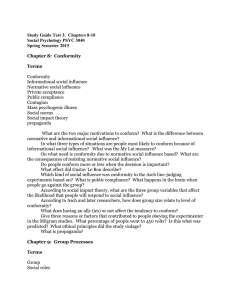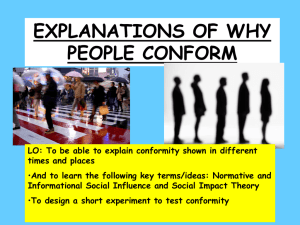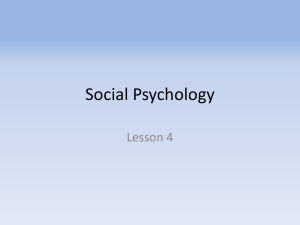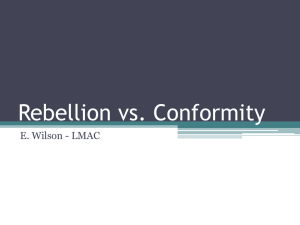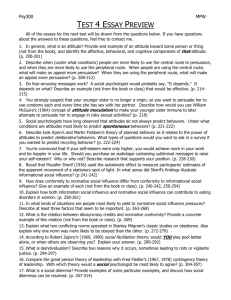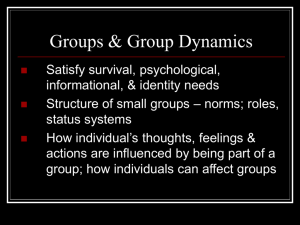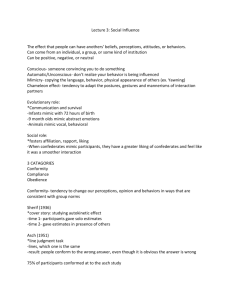Learning Objectives Chapter 8 Conformity
advertisement
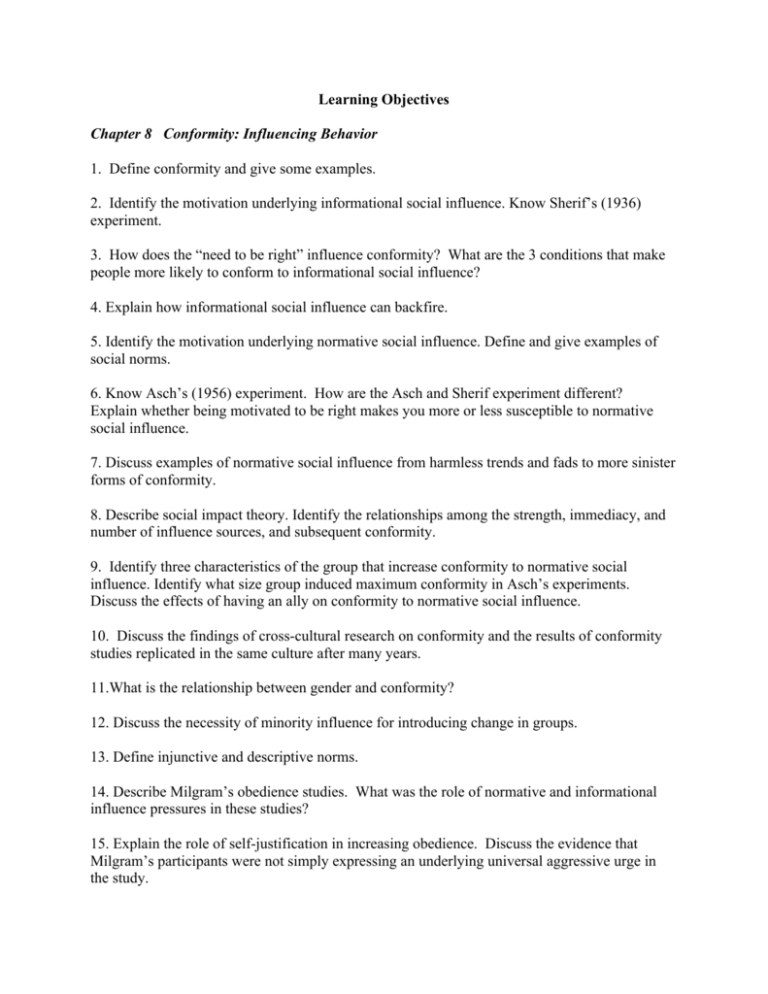
Learning Objectives Chapter 8 Conformity: Influencing Behavior 1. Define conformity and give some examples. 2. Identify the motivation underlying informational social influence. Know Sherif’s (1936) experiment. 3. How does the “need to be right” influence conformity? What are the 3 conditions that make people more likely to conform to informational social influence? 4. Explain how informational social influence can backfire. 5. Identify the motivation underlying normative social influence. Define and give examples of social norms. 6. Know Asch’s (1956) experiment. How are the Asch and Sherif experiment different? Explain whether being motivated to be right makes you more or less susceptible to normative social influence. 7. Discuss examples of normative social influence from harmless trends and fads to more sinister forms of conformity. 8. Describe social impact theory. Identify the relationships among the strength, immediacy, and number of influence sources, and subsequent conformity. 9. Identify three characteristics of the group that increase conformity to normative social influence. Identify what size group induced maximum conformity in Asch’s experiments. Discuss the effects of having an ally on conformity to normative social influence. 10. Discuss the findings of cross-cultural research on conformity and the results of conformity studies replicated in the same culture after many years. 11.What is the relationship between gender and conformity? 12. Discuss the necessity of minority influence for introducing change in groups. 13. Define injunctive and descriptive norms. 14. Describe Milgram’s obedience studies. What was the role of normative and informational influence pressures in these studies? 15. Explain the role of self-justification in increasing obedience. Discuss the evidence that Milgram’s participants were not simply expressing an underlying universal aggressive urge in the study. Chapter 9 Group Processes: Influence in Social Groups 1. Provide a definition of groups and explain their typical composition. 2. Describe the typical size of most groups, and explain two reasons why members tend to be homogenous. 3. Define roles and the function they serve in social groups. Identify two possible costs to social roles and discuss their implications. Discuss the potential costs of gender roles in particular. 4. Define group cohesiveness and discuss its benefits and costs for the group. What are the consequences for violating group norms? 5. Discuss the effects of social facilitation on the performance of simple and difficult tasks. 6. Describe social loafing and discuss why it occurs. Are there gender differences? 7. Define deindividuation and describe the effects of deindividuation on behavior. 8. Identify the antecedents, symptoms, and consequences of groupthink. Discuss historical examples of groupthink. Identify measures that can be taken to avoid groupthink. 9. Describe the effects of group discussion on attitudes that are initially risky or initially cautious. 10. Describe the type of conflict known as a social dilemma (there are several). 11. Identify why successful resolution of negotiations can be hard to achieve, and what processes may help. Chapter 10 Interpersonal Attraction: From First Impressions to Close Relationships 1. Describe the role of propinquity in attraction. Distinguish between physical and functional distance. Explain why the propinquity effect works. 2. Discuss the importance of similarity in attraction. Describe how it works! 3. Discuss the importance of reciprocal liking in attraction. Discuss the role of self-esteem in reciprocal liking. 4. Discuss the consequences of physical attractiveness for liking strangers and for maintaining relationships. 5. Describe the underlying variable that links attractiveness, propinquity, and similarity. REVIEW: Describe the “what is beautiful is good” stereotype and explain how this stereotype might produce a self-fulfilling prophecy. 6. Identify the basic concepts of social exchange theory. Distinguish between comparison level and comparison level for alternatives. 7. Describe equity theory and indicate how partners in a relationship respond when they are overor under-benefited in an inequitable relationship. 8. Distinguish between passionate and companionate types of love proposed by Hatfield. 9. Identify the combinations of intimacy, passion, and commitment that produce the various types of love outlined in Sternberg’s triangular theory of love. 10. Define the six styles of love according to Hendrick and Hendrick. Identify gender differences in love styles. 11. Discuss cultural differences in how people label the experiences of romantic love and in how they make decisions to marry. Identify cultural differences in love styles. 12. Describe how Rusbult’s investment model extends social exchange theory. Identify the three things we need to know in order to predict whether people will stay in an intimate relationship. 13. Describe how partners’ concerns with equity differ depending on whether the partners are involved in an exchange or in a communal relationship. 14. Identify the key assumption of attachment theory and distinguish between the three attachment styles. 15. Discuss research findings in the area of relationship dissolution. Identify the most important determinant of how people feel after a romantic relationship is terminated.
